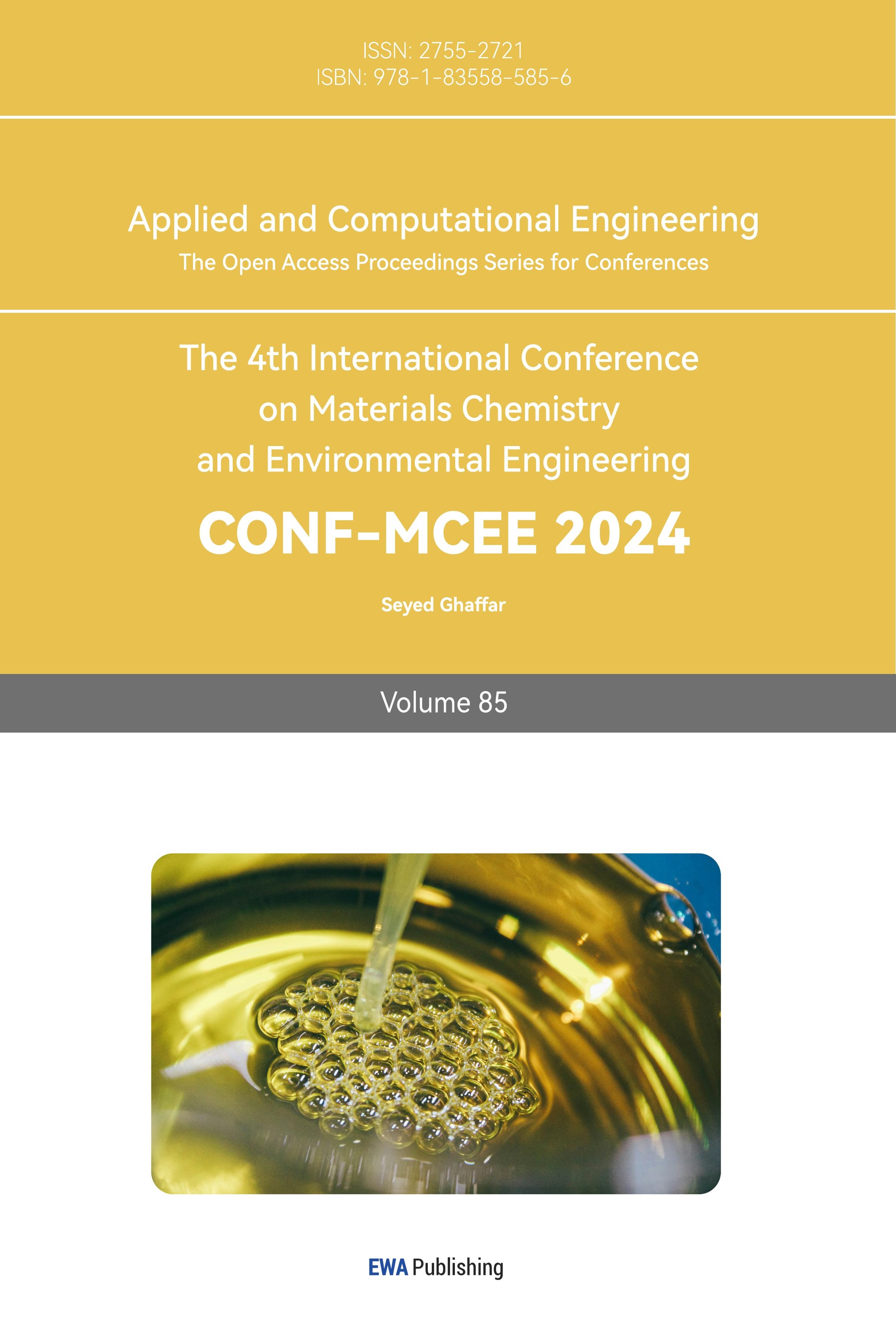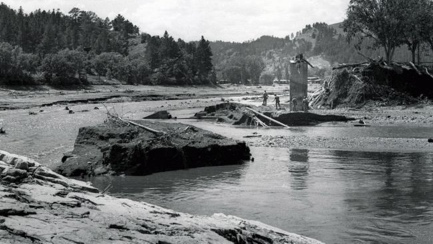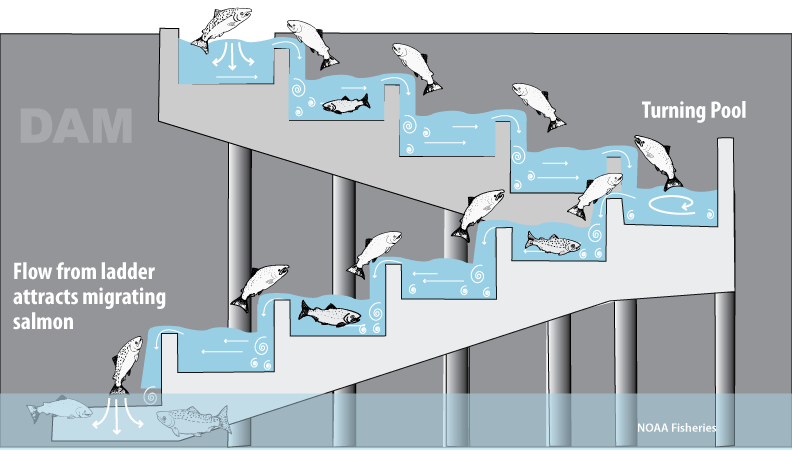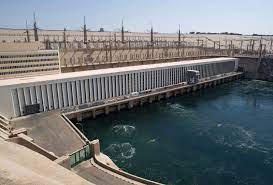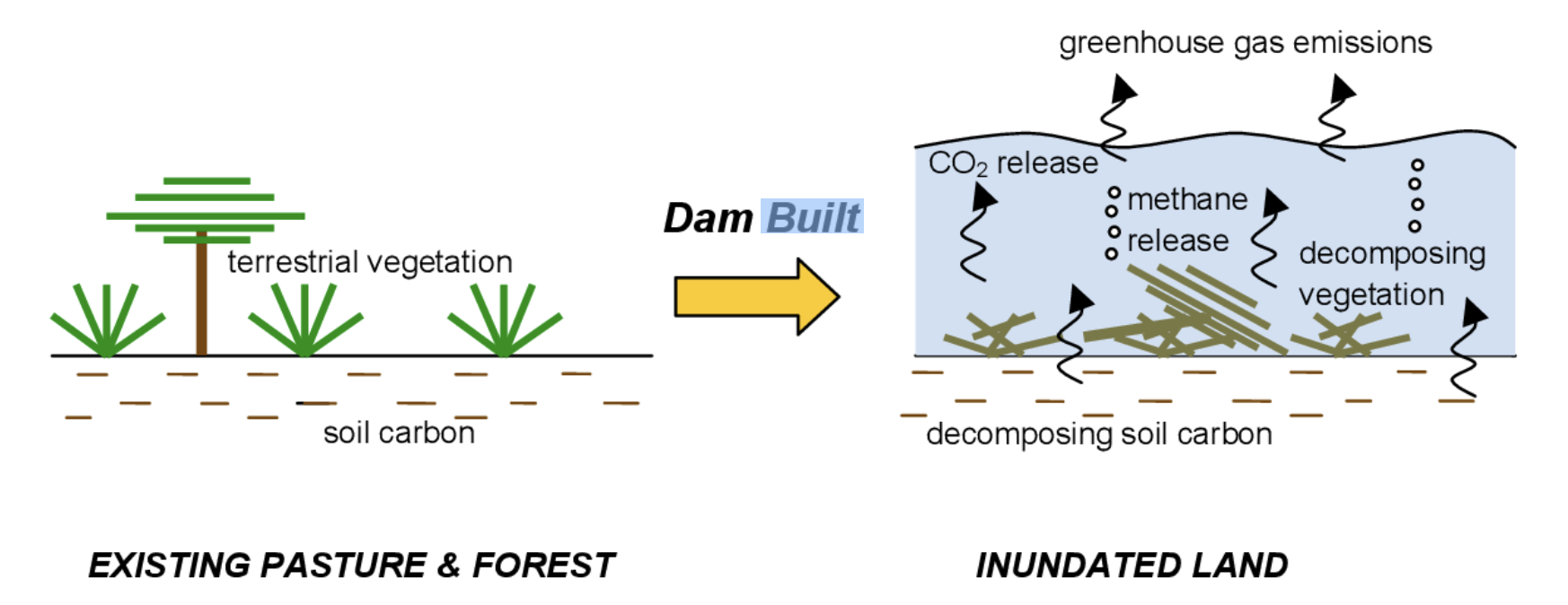1.Introduction & history
Hydropower is a type of renewable energy that produces electricity by harnessing the force of moving water. It is a clean, sustainable energy source that can lessen climate change’s effects by reducing greenhouse gas emissions. With 16% of the world’s electricity generated by it, it is the most widely used renewable energy source [1].
The waterwheel was an essential invention during China’s Han Dynasty, which ruled from 202 BC to 9 CE. It was a device that used the force of water to turn a wheel, which could then be used to power machinery and lift water for irrigation or grinding grains. The revolution was positioned in a river or stream so that the water’s flow could turn it. The buckets or paddles would scoop up water as the wheel turned and then release it, keeping the wheel turning. In general, the development of the waterwheel during the Han Dynasty was a significant technological advance that significantly affected Chinese agriculture, industry, and society [2].
The Appleton Paper and Pulp Company in Wisconsin, USA, installed a water turbine generator on the Fox River in 1882, the country’s first hydroelectric power plant for industrial purposes. The Grand Rapids Electric Light and Power Company constructed several hydroelectric power plants that generated electricity on the Grand River. In 1891, Siemens and Halske used a hydroelectric power plant on the Neckar River in Lauffen, Germany, to demonstrate the first AC power transmission system. Frankfurt received the power over a 175 km distance, a significant development for electrical power systems. The Folsom Powerhouse in California was the first hydroelectric power plant to produce electricity for a long-distance transmission system when it was built in 1895.
In the quest for sustainable energy, hydropower is a beacon. The paper is of great significance by delving into the historical, technological, systemic, environmental, and economic aspects of hydropower and addressing issues of global concern. Tracing the history of hydropower reveals its evolution from ancient waterwheels to modern turbines, offering lessons for contemporary energy policy and innovation. The paper highlights innovative engineering, advanced hydroelectric technology, and optimizing energy production for a sustainable future. Examining hydroelectric mechanics, hydrology, and control systems provides a blueprint for operations, maintenance, and improvements. Assess environmental impacts, including habitat destruction and emission reductions, to guide sustainable energy strategies. Analysis of investment costs, expenditures, and revenue generation informs decisions about fiscally responsible energy projects. Hydropower enriches the global renewable energy discussion, contributing to energy transition and climate change mitigation efforts. The paper’s interdisciplinary approach fosters collaboration, uniting expertise across fields to deliver holistic energy solutions. In the grand picture of energy production, hydropower becomes a dynamic thread linking history, technology, systems, environment, and economics. The research paper weaves these threads to illuminate the path to a sustainable energy future. As the world faces an era of environmental urgency and energy transition, the insights in this paper can serve as a guiding light to inspire the harmonious coexistence between human progress and the conservation of the planet.
2.Physics and technology principles
Several types of turbines are used in hydropower plants, including Pelton, Francis, and Kaplan turbines. High head sites—where the water falls from a great height—are suitable for Pelton turbines, also called impulse turbines. A fast-moving jet of water is directed onto the turbine blades, spinning the device. The cups or buckets mounted around the turbine wheel’s perimeter receive the water jet’s intended target. Pelton turbines have several benefits, including a simple design, high efficiency, and minimal maintenance. They work well in mountainous areas with a lot of water available and sharp elevation changes (Figure 1).
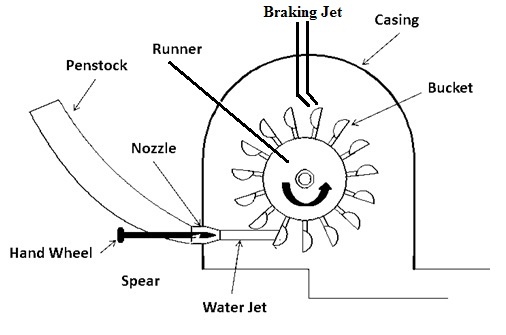
Figure 1. The picture of a Pelton turbine
Reaction turbines, or Franci’s turbines, are frequently used for medium-head sites where the water flows through the turbine blades instead of being directed onto them in a high-speed jet. After passing through several stationary guide vanes that are stationary, when the water enters the turbine through a spiral casing, the water is directed onto the turbine blades. Curved blades effectively capture water energy and transform it into mechanical energy [3]. Franci’s turbines have several benefits, including high efficiency, minor maintenance, and a small footprint (Figure 2).
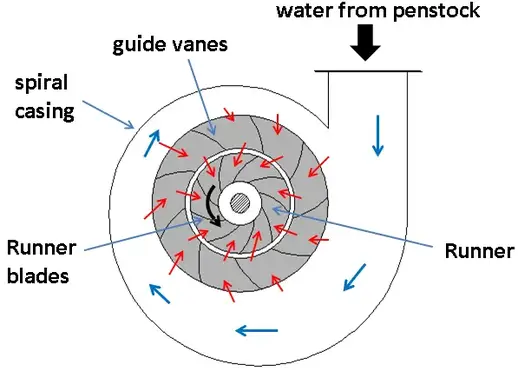
Figure 2. The picture of a Francis turbine
Additionally, they work well in locations with a medium head of water. Propeller turbines, or Kaplan turbines, are frequently used for low-head sites where the water passes slowly through the blades. After passing through several movable guide vanes that direct the water onto the turbine blades, the water enters the turbine through a spiral casing. To effectively capture the energy of the water and transform it into mechanical energy, the edges are shaped like propellers [4]. Kaplan turbines have several benefits, such as high efficiency, minor maintenance, and a small design. They are also suitable for use with low available water pressure (Figure 3).
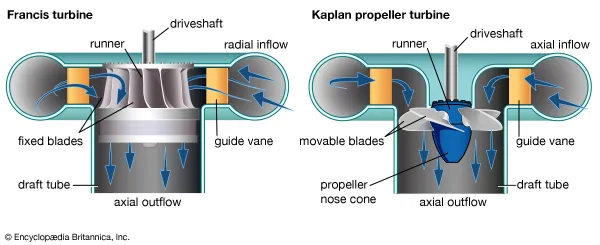
Figure 3. The picture of a Kaplan turbine
Run-of-river and storage hydropower plants are the two main categories. Run-of-river hydropower plants convert some river flow through a turbine to produce electricity without storing water in a reservoir. Typically, these plants have a high river flow and a low head of water. In a run-of-river plant, the water from the river is diverted through an intake structure and directed through a penstock, a sizable pipe, to the turbine. The turbine transforms the mechanical energy of the water’s flow into electrical energy, which is then used to power a generator to generate power. Without being kept in a reservoir, the water is returned to the river downstream of the plant after passing through the turbine.
On the other hand, storage hydropower plants keep water in a reservoir and release it as needed to produce electricity [5]. Typically, these plants are used in regions with high heads and low river flow. In a storage facility, water is kept in a dam-built reservoir. Water is released from the reservoir through a penstock during high electricity demand to power a turbine and produce electricity. The water is returned to the pool after passing through the turbine. The water is kept in the reservoir for later use when electricity demands are low.
3.System description
Although there are two types of hydropower systems, run-of-the-river systems and pumped storage systems, the main components of the entire system are similar, mainly the following eight types:
•Forebay. In real life, the demand for electricity in energy and production is staged. During the peak period of electricity consumption, more electricity will be needed at night than during the day. If you unthinkingly rely on the natural flow of water, it may not be enough to support the power supply area. Electricity demand, forebay is the key to solving this problem. It is the basin area of the hydropower station. The water flow will be temporarily stored before it enters the water intake chamber. After reaching the local electricity demand, the water flow will flow into the water intake chamber and generate electricity through turbines and generators (Figure 4).
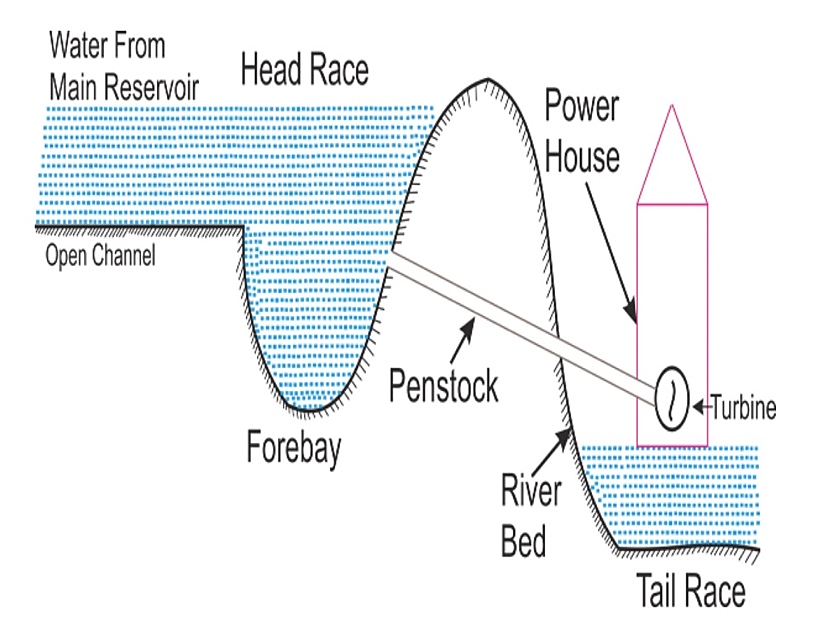
Figure 4. The diagram of the forebay
•Intake structure. The intake structure connects the forebay and penstock structure; it can collect the water flow stored in the forebay structure and pour it into the pressure pipe. This is due to the influence of local geological and climatic conditions. Usually, the water cannot be directly introduced into the pressure pipe. Otherwise, it will cause the failure of the whole system, increase the maintenance cost, and shorten the system’s service life [6].
•Penstock. In most cases, penstock will choose to build on a slope with an inclination to transport the water stored in the forebay or reservoir to the hydropower station. Penstocks are made of steel or reinforced concrete. Since the water flow in the penstock also flows from a high place to a low altitude area, the impact of the water flow itself will bring a non-negligible water hammer effect with the opening and closing of the penstock valve [7] (Figure 5).
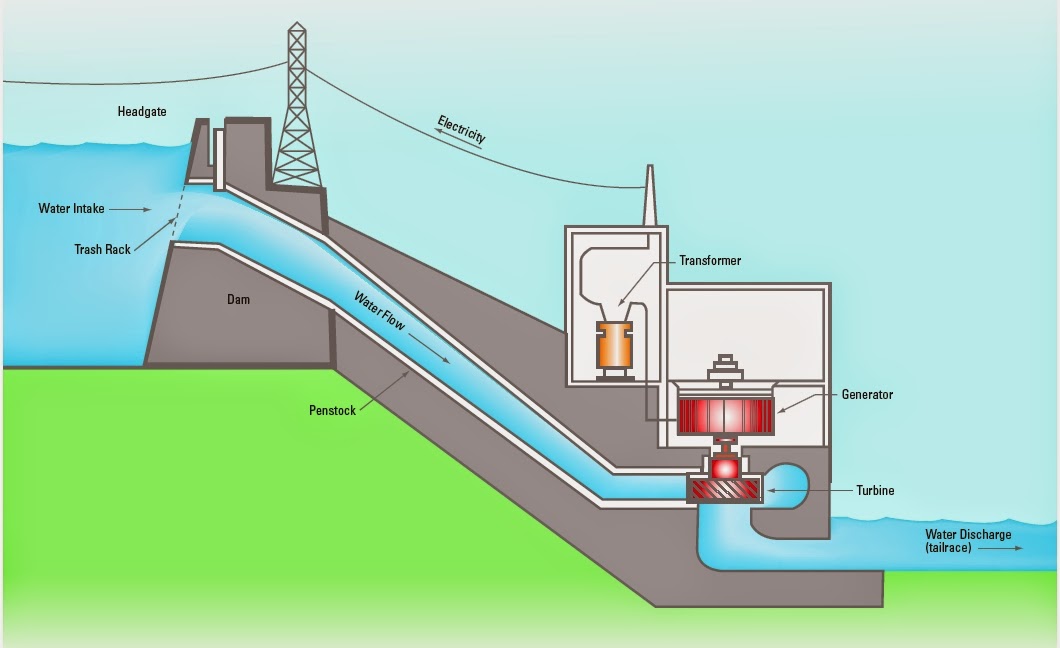
Figure 5. The diagram of penstock
•Surge tank. The surge tank is the device mentioned above that prevents the penstock from being damaged by the massive pressure of the water hammer effect. The cylindrical tank or chamber connected to it is as close as possible to the hydropower station to ensure that the average water flowing into the hydropower station through the pipeline is Pressurized water flow. Its top is open to the atmosphere to achieve the pressure balance in the penstock [8].
•Turbine. The turbine is the most essential part of the hydroelectric power generation system, which determines the entire system’s operation. It mainly relies on the high pressure of the water flow to impact the circular turbine blades or the runner to rotate so that the shaft in the center of the turbine rotates and drives the edges of the generator coupled on the same post to rotate and convert the potential energy of the water flow into mechanical energy and then into electrical power (Figure 6).
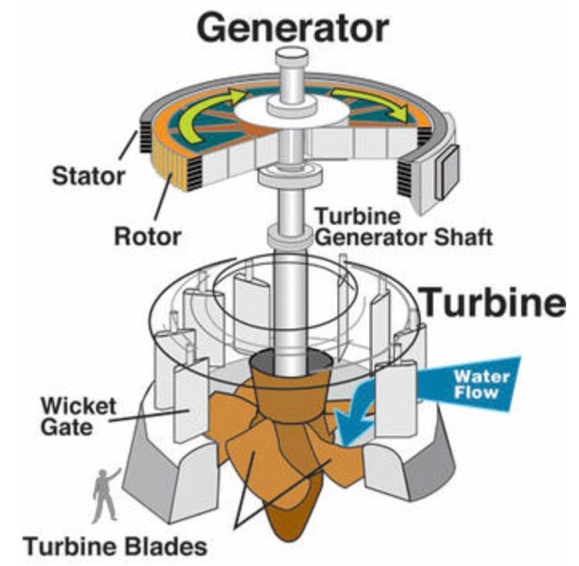
Figure 6. The diagram of the turbine
•Powerhouse. This building protects equipment so that the system can provide stable water and power supply. It is divided into upper and lower parts. The upper part is some foundation structures, which can facilitate the construction of power plants. Generators and turbines will be built on the upper ground floor.
•Draft tube. The draft tube is an indispensable part of the reaction turbine, which is connected between the turbine’s outlet and the tailrace’s middle. Its diameter gradually increases from tiny to small, which can facilitate the smooth flow of water into the tailrace.
•Tailrace. For hydroelectric power stations that are far away from the river, it is a channel that introduces tail water into the river. If the tailwater is discharged randomly, it will not significantly impact the local ecological environment.
The above are the essential components of the hydroelectric power generation system, and each part plays a significant role in the entire power generation process and is indispensable.
4.System integration into the energy grid
This section describes how the renewable energy system will be integrated into the electricity grid and any additional technologies needed for storage, transmission, and energy balancing [9]. The sequence of events connecting hydropower to the grid widely applies to fixed and variable-speed hydropower systems. There are two common ways to connect hydro to the grid:
•Fixed-speed induction generator (FSIGs). Fixed-speed induction generator uses a squirrel-cage induction generator directly connected to the grid to generate electricity. It is the most common method for grid-connected hydropower systems and is used for most turbines. It is characterized by stability and high efficiency. It operates by rotating at a higher than synchronous speed since the primary power source is the turbine’s rotation rather than the impact of the water flow.
•Grid-tied inverter. Since most electrical appliances use alternating current, it can be more stable and save more power during use. An inverter is a device that converts direct current into alternating current. In hydropower applications, two inverters are used, from the generator to the inverter rectifier and then to the grid.
While both methods feed electricity from power plants into the grid, there are huge differences. In terms of operation, FSIGs are used together with turbines or other mechanical devices that can continuously rotate and are driven to rotate synchronously through coaxial bonding, which can generate a specific electrical frequency and output power [10]. The grid-tied inverter is not constant and can adapt to different input voltages and frequencies. For efficiency, FSIGs require reactive power compensation. They are difficult to control the output power, and the efficiency is also highly dependent on the operating speed of the load, which is a big problem for variable flow rates in hydropower. The grid-tied inverter has higher efficiency. They can actively manage output power and voltage, ensuring smooth synchronization with the grid. Modern grid-connected inverters also include features such as maximum power point tracking (MPPT) to optimize energy harvesting and increase the overall efficiency of renewable energy systems.
FSIG is more suitable for constant-speed applications, while grid-connected inverters offer greater flexibility and efficiency, making them more popular in modern renewable energy systems.
5.Environmental impact
In this part, hydropower’s environmental benefits and drawbacks are discussed in a generic view, mainly in hydrological, physical, and social aspects.
Throughout history, hydropower has been proven to bring many environmental benefits (listed in Table 1). Take the Three Gorges Dam as an example, it plays a crucial role in controlling the flooding of the Yangtze River: the dam’s reservoir can store up to 22 cubic kilometers of water, which can be released slowly during periods of heavy rain to prevent downstream flooding. Lastly, the dam’s 32 turbines have a total generating capacity of 22,500 megawatts, making it the world’s largest hydroelectric power station [11].
Table 1. Benefits of hydropower
|
Job creation |
construction, maintenance, and operation |
|
Increased land values |
agricultural and recreational uses |
|
Improved transportation |
providing navigation and regulating the flow of water |
|
Increased tourism |
fishing, boating, and camping |
|
Flood Control |
economic benefits for communities located downstream |
|
Improved water supply |
irrigation, drinking water, and industrial uses |
|
Energy production |
Convert gravitational potential energy to electricity |
On the other hand, many dams are negatively impacting the environment, including the Three Gorges dam. To begin with, hydropower plants are hydrologically harmful by (majors) rearranging the resources, modifying sediment transport, increasing water evaporation, affecting groundwater supply, (minors) etc. Hydropower typically requires the construction of dams, reservoirs, and canals to divert water to turbines. This can significantly alter the natural flow of rivers and change the distribution of water resources. It can also significantly affect the transport of sediment in rivers. As water is stored behind a dam, sediment can accumulate in the reservoir, leading to erosion and loss of habitat downstream. Unlike natural water bodies, pools behind barricades can cause increased evaporation rates. Lastly, the groundwater supply downstream is affected due to flow modification upstream (Figure 7).
Moreover, physical impacts, including dam failures, fish ecology, silt accumulation, and methane release, have led to serious concerns about the implementation of hydropower. Dams can fail for various reasons, such as poor construction, design flaws, or natural disasters. The most influential factor of failures is overtopping, as seen in Figure 7 [12]. Followed by dam failures are catastrophic consequences, leading to loss of life and significant environmental damage. For fish ecology, hydropower projects can significantly impact migratory fish species by blocking fish migration routes and altering the natural flow of rivers. Dams can also cause silt accumulation in the reservoir behind the barrier, reducing the reservoir’s capacity and affecting downstream water quality; silt accumulation can also impact fish populations by altering their habitat. Lastly, the decomposition of organic matter in reservoirs can release methane, a potent greenhouse gas, and the emissions can contribute to climate change and negatively impact the environment. The following Table 2 are examples of each physical impact [13].
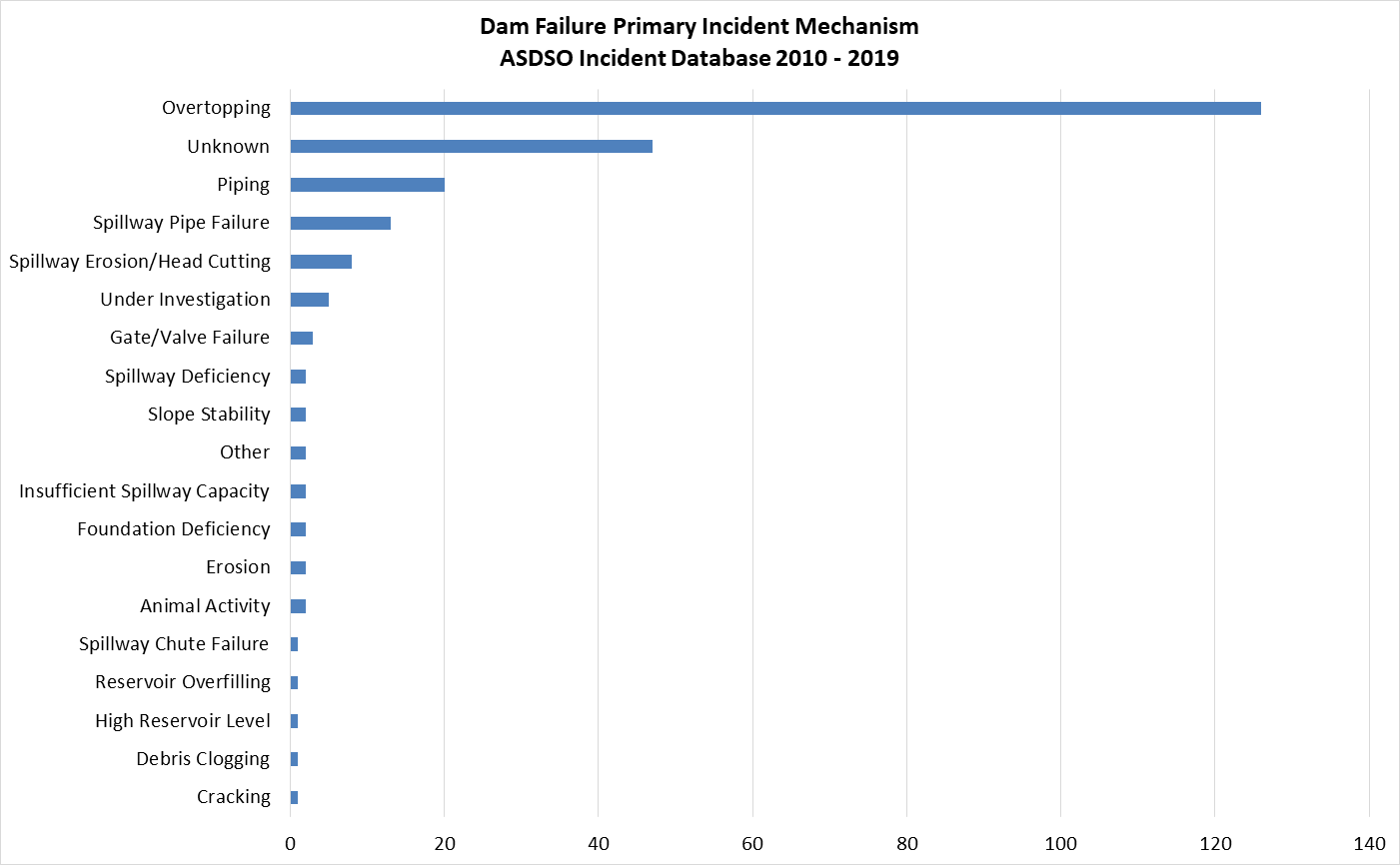
Figure 7. Dam Failure primary incident mechanism from 2010-2019
Table 2. Cases related to physical effects
|
Dam failures |
Canyon Lake Dam (June 9, 1972): A severe thunderstorm caused flooding that killed 238 people and caused millions of dollars in property damage in Rapid City. |
|
|
Fish ecology |
In the early twentieth century, France had many dams constructed on rivers previously used by Atlantic fish, which caused migratory barriers. |
|
|
Silt accumulation |
Aswan High Dam, built in Egypt in the 1960s, forms silt accumulation, leading to massive agricultural system damage and increased use of fertilizers. |
|
|
Methane release |
In the early 21st century, the reservoir lake of a hydroelectric plant on the River Aare in northern Switzerland had a total annual methane release of about 150 tonnes (almost 4000 tonnes of CO2). |
|
Lastly, dams cause the relocation of large populations. As barriers are built, numerous buildings are submerged, and many people suffer homelessness. Though governments provide compensation, the locals’ property and intangible losses are often hard to quantify, leading to protests and social chaos [14].
Every green technology is a double-edged sword, so it’s crucial to analyze the benefits and drawbacks before implementation to minimize environmental risks and maintain regular inspections to prevent failure after being built.
6.System economics
Hydropower is one of the oldest and most widely used forms of renewable energy. The economic impact of hydropower can be analyzed from different perspectives, mainly about its financial cost, and others include contribution to energy security, employment generation, economic growth, and environmental sustainability.
To begin with, hydropower’s cost greatly depends on its initial cost. There’s one general pattern of the economic cost of reliable power plants: the higher the initial cost (more extensive the storage), the lower the Levelized Cost of Electricity (LCOE) (See Table 3). Initial cost involves civil engineering cost (65%-75%), environmental criteria cost(15%-20%), and turbo generator and control systems(10%). The Levelized Cost of Electricity is a metric used to estimate the average cost of generating a unit of electricity over the lifetime of a power plant or system [15].
Table 3. The scale of the hydropower plant and its relative LCOE
|
Hydro plant rating |
Cost of electricity/p kWh-1 |
|
<100 kW |
12.6 |
|
500 kW-2 MW |
9.5 |
|
5-16 MW |
9.7 |
|
Lange storage (100 MW) |
8.0 |
The maintenance cost is low, followed by construction, since hydropower plants don’t require fuel. Also, electricity generation income compensates for part of the maintenance cost. As a result, the overall cost of hydropower plants is mainly determined by the initial cost, while maintenance cost is insignificant.
Considering the specialty of hydropower, it contributes to energy security by providing a reliable and constant source of electricity that is not affected by fuel price fluctuations or geopolitical tensions. This is particularly important in countries that rely heavily on imported fossil fuels for their energy needs, as hydropower can reduce dependence on foreign energy sources and increase energy independence. It can also stimulate economic growth by providing affordable electricity to industries and businesses, increasing productivity and competitiveness. The hydropower projects can attract investment and promote regional development by improving infrastructure and access to electricity.
In addition, hydropower projects require significant construction and maintenance work, which can create jobs in local communities. In addition, the production and distribution of hydropower equipment and technology can create employment opportunities in the manufacturing and service sectors.
Lastly, hydropower is a clean and renewable energy source that produces little greenhouse gas emissions or air pollution [16]. It also helps to reduce water pollution and improve the quality of life for local communities.
Overall, the economic impact of hydropower is complex and depends on various factors, including the location and scale of the project, the social and environmental context, and the regulatory framework in place. To maximize the economic benefits of hydropower while minimizing its negative impacts, it is essential to balance the initial cost and maintenance cost, carefully assess each project on a case-by-case basis, and involve local communities and stakeholders in the decision-making process.
7.Summary and Conclusions
There are several vital observations when considering hydropower technology and its role in the global economic environment:
•Hydropower technology is widely recognized as a sustainable renewable energy source that is key in mitigating global warming and reducing dependence on fossil fuels.
•The construction of hydropower stations will impact the local ecosystem, especially fishery resources and wildlife habitats.
•The construction of hydropower stations may also cause large-scale population displacement and affect economic development.
Therefore, policymakers and investors must balance developing hydropower and reducing environmental impact. For future hydropower projects, the responsibility for environmental protection should be integrated into their design and implementation process, and education and regulations are needed to increase community, government, and business support for hydropower projects.
References
[1]. Hydropower basics, Energy.gov, Available at: https://www.energy.gov/eere/water/hydropower-basics (Accessed: April 17, 2023).
[2]. Han, H. (2013), ‘China’s Policymaking in Transition,’ The Journal of Environment & Development [Preprint], Available at: https://doi.org/10.1177/1070496513496105.
[3]. Different Types of Turbines Used in Hydroelectric Power Plants, Available at: https://www.tutorialspoint.com/different-types-of-turbines-used-in-hydroelectric-power-plants.
[4]. Mishra, G. (2014), ‘TYPES OF HYDRO POWER PLANTS,’ The Constructor [Preprint], Available at: https://theconstructor.org/water-resources/types-of-hydro-power-plants/9554/.
[5]. Sadanandam. A, Components of Hydropower Plant and their Functions, Available at: https://theconstructor.org/structures/hydropower-plant-components-functions/19705/
[6]. Electrical Technology, Hydropower Plant – Types, Components, Turbines and Working, Available at: https://www.electricaltechnology.org/2021/07/hydropower-plant.html
[7]. Sewervue, Penstock Condition Assessment with State-of-the-Art Technology, Available at: https://sewervue.com/penstock-assessment.html
[8]. Mechanical Tutorial, Types Of Hydroelectric Power Plant or Hydroelectric Power Station, Available at: https://www.mechanicaltutorial.com/classification-of-hydro-electric-power-plant-or-hydro-electric-power-station
[9]. Water Science School (2018), Hydroelectric Power: How it Works, Available at: https://www.usgs.gov/special-topics/water-science-school/science/hydroelectric-power-how-it-works, (Accessed: June 6, 2018)
[10]. Water Power Technologies Office, How Hydropower Works, Available at: https://www.energy.gov/eere/water/how-hydropower-works
[11]. Trevor M. L. (2022), Comprehensive Renewable Energy, Elsevier Science
[12]. Bin. W, et.al (2011), ‘Fixed-Speed Induction Generator WECS’, Wiley-IEEE Press, pp. 173-189, 10.1002/9781118029008.ch6
[13]. ASDSO, A.not S.dam safety officials (no date) Dam failures and incidents, Dam Failures and Incidents | Association of State Dam Safety. Available at: https://damsafety.org/dam-failures (Accessed: April 18, 2023).
[14]. Omar, N., Mahmoud, R. & Barkat, H. (2011), ‘Stability improvement of fixed speed induction generator wind farm using STATCOM during different fault locations and durations’, Ain Shams Engineering Journal, 2, pp.1-10, 10.1016/j.asej.2011.04.00
[15]. Rivers, A. (2022) How dams damage rivers, How Dams Damage Rivers Comments. Available at: https://www.americanrivers.org/threats-solutions/restoring-damaged-rivers/how-dams-damage-rivers/ (Accessed: April 18, 2023).
[16]. Peake, S. (2018) “Hydroelectricity,” in Renewable energy: Power for a sustainable future. Oxford: Oxford University Press in association with the Open University, pp. 327–390.
Cite this article
Mi,Y. (2024). A historic, technological, systematic, environmental, and economic introduction of hydro power. Applied and Computational Engineering,85,1-9.
Data availability
The datasets used and/or analyzed during the current study will be available from the authors upon reasonable request.
Disclaimer/Publisher's Note
The statements, opinions and data contained in all publications are solely those of the individual author(s) and contributor(s) and not of EWA Publishing and/or the editor(s). EWA Publishing and/or the editor(s) disclaim responsibility for any injury to people or property resulting from any ideas, methods, instructions or products referred to in the content.
About volume
Volume title: Proceedings of the 4th International Conference on Materials Chemistry and Environmental Engineering
© 2024 by the author(s). Licensee EWA Publishing, Oxford, UK. This article is an open access article distributed under the terms and
conditions of the Creative Commons Attribution (CC BY) license. Authors who
publish this series agree to the following terms:
1. Authors retain copyright and grant the series right of first publication with the work simultaneously licensed under a Creative Commons
Attribution License that allows others to share the work with an acknowledgment of the work's authorship and initial publication in this
series.
2. Authors are able to enter into separate, additional contractual arrangements for the non-exclusive distribution of the series's published
version of the work (e.g., post it to an institutional repository or publish it in a book), with an acknowledgment of its initial
publication in this series.
3. Authors are permitted and encouraged to post their work online (e.g., in institutional repositories or on their website) prior to and
during the submission process, as it can lead to productive exchanges, as well as earlier and greater citation of published work (See
Open access policy for details).
References
[1]. Hydropower basics, Energy.gov, Available at: https://www.energy.gov/eere/water/hydropower-basics (Accessed: April 17, 2023).
[2]. Han, H. (2013), ‘China’s Policymaking in Transition,’ The Journal of Environment & Development [Preprint], Available at: https://doi.org/10.1177/1070496513496105.
[3]. Different Types of Turbines Used in Hydroelectric Power Plants, Available at: https://www.tutorialspoint.com/different-types-of-turbines-used-in-hydroelectric-power-plants.
[4]. Mishra, G. (2014), ‘TYPES OF HYDRO POWER PLANTS,’ The Constructor [Preprint], Available at: https://theconstructor.org/water-resources/types-of-hydro-power-plants/9554/.
[5]. Sadanandam. A, Components of Hydropower Plant and their Functions, Available at: https://theconstructor.org/structures/hydropower-plant-components-functions/19705/
[6]. Electrical Technology, Hydropower Plant – Types, Components, Turbines and Working, Available at: https://www.electricaltechnology.org/2021/07/hydropower-plant.html
[7]. Sewervue, Penstock Condition Assessment with State-of-the-Art Technology, Available at: https://sewervue.com/penstock-assessment.html
[8]. Mechanical Tutorial, Types Of Hydroelectric Power Plant or Hydroelectric Power Station, Available at: https://www.mechanicaltutorial.com/classification-of-hydro-electric-power-plant-or-hydro-electric-power-station
[9]. Water Science School (2018), Hydroelectric Power: How it Works, Available at: https://www.usgs.gov/special-topics/water-science-school/science/hydroelectric-power-how-it-works, (Accessed: June 6, 2018)
[10]. Water Power Technologies Office, How Hydropower Works, Available at: https://www.energy.gov/eere/water/how-hydropower-works
[11]. Trevor M. L. (2022), Comprehensive Renewable Energy, Elsevier Science
[12]. Bin. W, et.al (2011), ‘Fixed-Speed Induction Generator WECS’, Wiley-IEEE Press, pp. 173-189, 10.1002/9781118029008.ch6
[13]. ASDSO, A.not S.dam safety officials (no date) Dam failures and incidents, Dam Failures and Incidents | Association of State Dam Safety. Available at: https://damsafety.org/dam-failures (Accessed: April 18, 2023).
[14]. Omar, N., Mahmoud, R. & Barkat, H. (2011), ‘Stability improvement of fixed speed induction generator wind farm using STATCOM during different fault locations and durations’, Ain Shams Engineering Journal, 2, pp.1-10, 10.1016/j.asej.2011.04.00
[15]. Rivers, A. (2022) How dams damage rivers, How Dams Damage Rivers Comments. Available at: https://www.americanrivers.org/threats-solutions/restoring-damaged-rivers/how-dams-damage-rivers/ (Accessed: April 18, 2023).
[16]. Peake, S. (2018) “Hydroelectricity,” in Renewable energy: Power for a sustainable future. Oxford: Oxford University Press in association with the Open University, pp. 327–390.





